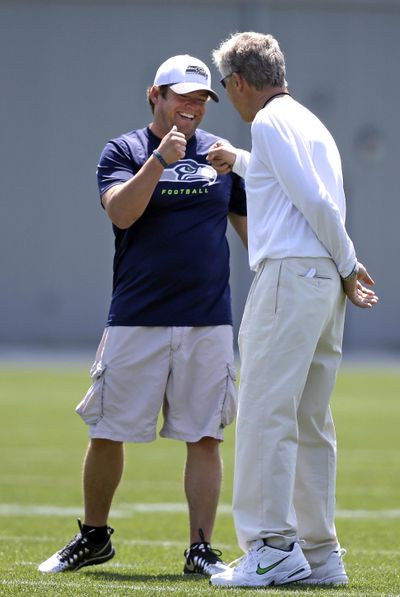Six years in, Schneider-Carroll team thrives for Seahawks

It was former Seahawks CEO Tod Leiweke who called the relationship between coach Pete Carroll and general manager John Schneider a “fantastic collaboration.”
Back then, in 2010, that description was nothing more than an article of faith. It was and is the type of thing said at every introductory news conference, a promise that so rarely comes true.
And yet six years later, the Carroll-Schneider collaboration has proven to be, well, fantastic.
The Seahawks have made the playoffs five times, been to two Super Bowls and won one of them. It has been the greatest stretch in team history.
This is all brought up because it’s now known Carroll and Schneider will work together for at least four more years. Recently, Schneider signed a five-year extension and Carroll a three-year extension.
From their first day together, Carroll and Schneider have presented a united front. They compliment each other, they make jokes, and during the season Carroll does all of the talking to the media so there is only one message. They are always on the same page.
That has gone on for so long now that either they are both great actors and salesmen or it is true.
Right now is a good time to reflect on two points.
First, to reiterate just how fruitful the dynamic has been. It’s not hard to imagine that years from now people will nostalgically talk about this stretch as the franchise’s glory days.
Second, the challenge of their relationship never ceases to be a challenge. Carroll and Schneider have made it work for six years, and it doesn’t get any easier. It has been and will always be fragile.
“It’s tremendous because it’s rare,” former Packers general manager Ron Wolf said a couple years ago. “We kind of had that when Mike Holmgren and I were together at Green Bay. It was about the Packers, and it worked. That’s so important. It seems like such a small thing. Egos get in the way, and eventually when you have success somebody wants to take credit. And it’s usually somebody that had absolutely nothing to do with it. That’s the downfall of operations.”
Wolf, who is in the Hall of Fame, tacked on this addendum in 2013: “You just hope they can maintain it. Because at some point that bubble is going to burst. When that happens, it’s how you react to that.”
Carroll is one of the league’s best coaches; Schneider one of the league’s best general managers. Both have ego, and both have the pedigree to warrant such ego.
But looking back to one example shows how and why their relationship has worked, and it happens to involve their most famous and important player: quarterback Russell Wilson.
Schneider loved Wilson. He loved the way he “tilted” the field his way; you just had to focus on Wilson when he played. Schneider lobbied hard for him.
Carroll and his coaches weren’t immediately convinced. As offensive line coach Tom Cable said, “We were just trying to understand what he could see in a guy who was undersized at that position.”
Carroll said Schneider “convinced” him of Wilson’s value.
Yet when Carroll and his coaches watched Wilson on the field during his rookie season, they saw what Schneider saw.
The Seahawks had just invested pretty heavily in a veteran free-agent quarterback that same offseason, but Carroll named Wilson his starter.
Said offensive coordinator Darrell Bevell, “I’ve been in other organizations where that probably wouldn’t have been the case for a lot of reasons, whether it’s ego or money. Because all of those things came into play in that situation.”
Sports is built on ego. It’s nearly impossible to be successful and not be convinced of your abilities. The trick is managing that ego.
So often teams go sideways because of power struggles. It sometimes feels like the NFL is actually a season of “Game of Thrones.”
Carroll and Schneider have thus far made their relationship into a “fantastic collaboration,” and the challenge, as always, will be keeping it that way.